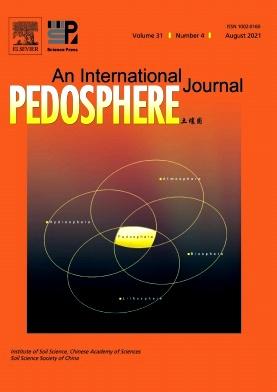除雪促进微生物介导的中国东北泥炭地有机碳聚集稳定化
IF 7.3
2区 农林科学
Q1 SOIL SCIENCE
引用次数: 0
摘要
全球气候变化对积雪具有深远的影响,进而影响微生物活动和团聚体土壤有机碳(SOC)的稳定性。北部泥炭地是重要的碳库,在减缓气候变化方面发挥着关键作用。然而,积雪变化对泥炭地团聚体中微生物介导的有机碳稳定性的影响尚不清楚。在此,通过现场模拟积雪条件(即积雪去除和积雪覆盖),研究积雪变化如何影响土壤微生物群落和土壤团聚体中相关的有机碳稳定性(>;2、0.25-2和<;0.25 mm),分布于中国东北泥炭地。结果表明,除雪显著提高了团聚体有机碳含量和稳定性。与积雪覆盖土壤相比,积雪清除导致表层土壤(0 ~ 30 cm深度)和底土(30 ~ 60 cm深度)土壤平均温度分别降低1.48°C和1.34°C,冻融循环增加11个循环,导致表层土壤和底土团聚体稳定性降低(分别降低23.68%和6.85%)。此外,微团聚体中存在更多的顽固性碳和增强的SOC稳定性(<;0.25毫米),在两个土壤深度。此外,除雪后,细菌多样性和网络稳定性也有所下降。结构方程模型分析表明,除雪间接促进了(P <;0.01)通过调节团聚体碳氮比(C:N)稳定有机碳。总体而言,我们的研究表明,微团聚体保护和适当的C:N比增强了碳固存对气候变化的响应。本文章由计算机程序翻译,如有差异,请以英文原文为准。
Snow removal promotes microbial-mediated organic carbon stabilization within soil aggregates in a peatland of Northeast China
Global climate change exerts profound effects on snow cover, with consequential impacts on microbial activities and the stability of soil organic carbon (SOC) within aggregates. Northern peatlands are significant carbon reservoirs, playing a critical role in mitigating climate change. However, the effects of snow variations on microbial-mediated SOC stability within aggregates in peatlands remain inadequately understood. Here, an in-situ field experiment manipulating snow conditions (i.e., snow removal and snow cover) was conducted to investigate how snow variations affect soil microbial community and the associated SOC stability within soil aggregates (> 2, 0.25–2, and < 0.25 mm) in a peatland of Northeast China. The results showed that snow removal significantly increased the SOC content and stability within aggregates. Compared to the soils with snow cover, snow removal resulted in decreased soil average temperatures in the topsoil (0–30 cm depth) and subsoil (30–60 cm depth) (by 1.48 and 1.34°C, respectively) and increased freeze-thaw cycles (by 11 cycles), consequently decreasing the stability of aggregates in the topsoil and subsoil (by 23.68% and 6.85%, respectively). Furthermore, more recalcitrant carbon and enhanced SOC stability were present in microaggregates (< 0.25 mm) at two soil depths. Moreover, reductions in bacterial diversity and network stability were observed in response to snow removal. Structural equation modeling analysis demonstrated that snow removal indirectly promoted (P < 0.01) SOC stability by regulating carbon to nitrogen (C:N) ratio within aggregates. Overall, our study suggested that microaggregate protection and an appropriate C:N ratio enhanced carbon sequestration in response to climate change.
求助全文
通过发布文献求助,成功后即可免费获取论文全文。
去求助
来源期刊

Pedosphere
环境科学-土壤科学
CiteScore
11.70
自引率
1.80%
发文量
147
审稿时长
5.0 months
期刊介绍:
PEDOSPHERE—a peer-reviewed international journal published bimonthly in English—welcomes submissions from scientists around the world under a broad scope of topics relevant to timely, high quality original research findings, especially up-to-date achievements and advances in the entire field of soil science studies dealing with environmental science, ecology, agriculture, bioscience, geoscience, forestry, etc. It publishes mainly original research articles as well as some reviews, mini reviews, short communications and special issues.
 求助内容:
求助内容: 应助结果提醒方式:
应助结果提醒方式:


